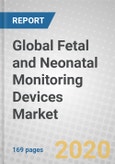The global market for fetal and neonatal monitors should grow from $4.8 billion in 2020 to $6.4 billion by 2025, at a compound annual growth rate (CAGR) of 6.1% for the period of 2020-2025.
- Fetal ultrasound market as a segment should grow from $1.2 billion in 2020 to $1.6 billion by 2025 at a CAGR of 5.7% through 2025.
- Fetal Dopplers market as a segment should grow from $1.2 billion in 2020 to $1.7 billion by 2025 at a CAGR of 6.8% through 2025.
Growth of the global market is attributed to increasing maternal complications, increasing preterm births and related complications, increasing prevalence of congenital anomalies, rising NICU admissions, increased use of technologically advanced devices in developed markets and rising awareness of fetal and neonatal birth complications in developing regions.
Report Scope
This report offers a detailed picture of the global fetal and neonatal monitor market. For the purpose of this study, the multi-parameter neonatal segment encompassed the market size of devices that monitor cardiac activity, pulmonary activity or both. A few devices in this segment also monitor NIBP, temperature, regional oximetry and other parameters. The market size excludes product accessories.
The report highlights the current and future market potential of fetal and neonatal monitors and provides a detailed analysis of the competitive landscape, regulatory scenario, drivers, restraints and opportunities in the market. The report covers market projections through 2025 and detailed epidemiology analysis of fetal and neonatal mortality.
The report details the market shares of fetal and neonatal monitors, by device type. Fetal monitors are sub-divided into fetal ultrasound, electronic fetal monitors, fetal Dopplers and others (fetoscopes, IUPC and fetal scalp electrodes). Neonatal monitoring devices are further sub-segmented into multi-parameter cardiopulmonary monitors, pulse oximeters and capnography equipment and others (temperature probes, blood pressure monitors, regional oximetry monitors and hearing assessment devices).
By region, the market has been segmented into North America, Europe, Asia-Pacific, South America, the Middle East and Africa. Detailed analyses of major countries such as the U.S., Canada, Germany, the UK France, Spain, Italy, Japan, China, India and Australia are included. Market estimates are provided with 2019 as the base year, with forecasts for 2020-2025. The estimated values are based on manufacturers’ total revenues. Projected and forecasted revenue values are in constant U.S. dollars, un-adjusted for inflation.
The report includes:
- 57 tables
- An overview of the global market for fetal and neonatal monitors
- Analyses of market trends, with data from 2019, estimates for 2020, and projections of compound annual growth rates (CAGRs) through 2025
- Information on common neonatal anomalies and discussion on clinical significance of neonatal tests and related equipment
- Insights into government initiatives and funding and a look at the healthcare investments in developing countries
- Explanation of the major drivers and regional dynamics of the global fetal and neonatal monitors market and evaluation of market size, market forecast, market share analysis and a relevant patent analysis
- Highlights of the new technological developments in fetal and neonatal monitors, and current technical issues within the industry
- Profile description of major market players including, The Cooper Companies Inc., Fujifilm Sonosite Inc., Koninklijke Philips, Medtronic PLC, Siemens Healthineers, and Spacelabs Healthcare Inc.
Reasons for Doing This Study
Globally, the burden of fetal and neonatal mortality is a great concern. Stillbirths are referred to as a silent epidemic. Increasing fetal and neonatal complications, maternal complications in pregnancy, preterm related birth complications and congenital disorders bring increased need for fetal and maternal monitoring during pregnancy. Healthcare vendors are constantly developing and offering innovative technologies to meet the challenges posed by complicated pregnancies, fetal and neonatal disorders. The global reduction of stillbirths and neonatal mortality is one the United Nations’ Sustainable Development Goals (SDGs).
The key objective for conducting this study is to provide an overview of the impact of all the latest developments in fetal and neonatal monitoring. The report provides the current and projected markets for fetal heart rate (FHR) monitors, fetal Dopplers, fetoscopes, fetal ultrasound systems, neonatal multi-parameter cardiopulmonary monitors, neonatal pulse oximeters, neonatal capnographs, neonatal blood pressure monitors, neonatal regional oximetry devices. Estimated figures for the different geographic regions give an idea of the global growth rates for these markets.
The report also provides profiles of about 15 companies participating in the market for fetal and neonatal monitoring. All relevant products from these companies are discussed in detail.
In this report, the following geographic regions were considered for market analysis:
- North America
- U.S.
- Mexico
- Canada
- Europe
- Germany
- France
- U.K.
- Italy
- Spain
- Rest of Europe (Switzerland, Denmark, Norway, Poland, Belgium, Austria, Netherlands, Sweden, Russia)
- Asia-Pacific
- Japan
- China
- India
- Rest of Asia-Pacific (Australia, New Zealand, Taiwan, Singapore, Malaysia, Thailand, Philippines, Korea, Indonesia)
- South America
- Argentina
- Brazil
- Chile
- Colombia
- Paraguay
- Peru
- Surinam
- Uruguay
- Middle East and Africa
- Algeria
- Egypt
- Iran
- Iraq
- Israel
- Jordan
- Kuwait
- Kenya
- Morocco
- Oman
- Qatar
- Saudi Arabia
- United Arab Emirates
- South Africa
- Sudan
Table of Contents
Samples

LOADING...
Companies Mentioned
- Drägerwerk AG & Co. KGaA
- Fujifilm Sonosite Inc.
- GE Healthcare
- Huntleigh Healthcare LLC
- Koninklijke Philips
- Masimo Corp.
- Medtronic plc
- Natus Medical Inc.
- Neoventa Medical
- Nonin Medical
- Siemens Healthineers
- Smiths Medical
- Spacelabs Healthcare Inc.
- The Cooper Companies Inc.








